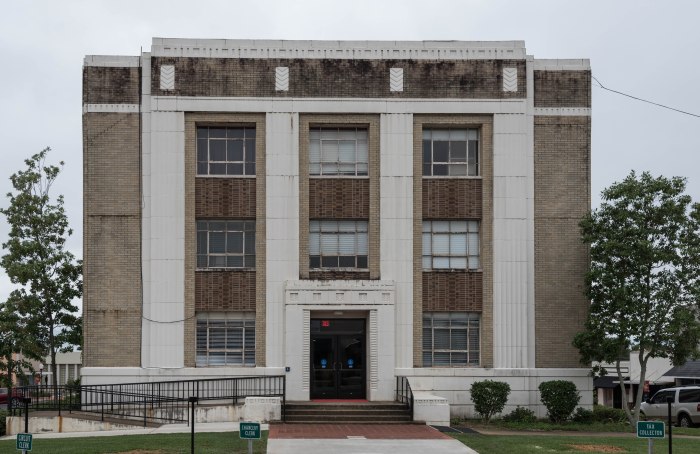 The Leake County Courthouse in Carthage is unique in that the entrances are on the narrow ends of the building. The courthouse square is a long narrow lot in the center of the town. I do not recall seeing another courthouse built with the entrances on the narrow side of the building–it reflects a “shotgun” approach to me, and it was actually a bit disorienting at first as I tried to find the entrance. The entrances are both similar, but the main entrance contains a small bas relief sculpture above the door, with a kneeling justice centered, with outstretched arms holding scales. (See detail below). The secondary entrance (pictured above) is similar, with slight variation in the detail.
The Leake County Courthouse in Carthage is unique in that the entrances are on the narrow ends of the building. The courthouse square is a long narrow lot in the center of the town. I do not recall seeing another courthouse built with the entrances on the narrow side of the building–it reflects a “shotgun” approach to me, and it was actually a bit disorienting at first as I tried to find the entrance. The entrances are both similar, but the main entrance contains a small bas relief sculpture above the door, with a kneeling justice centered, with outstretched arms holding scales. (See detail below). The secondary entrance (pictured above) is similar, with slight variation in the detail.
Edgar Lucian Malvaney designed the Art Deco style courthouse in 1935-36 as PWA Project Miss. 1042 (Mississippi Department of Archives and History, Historic Resources Inventory). J. R. Flint Construction Company built it. It was renovated and repaired in 1976 by architect Charles P. McMullan and Associates and builder/contractor W. G. Yates and sons. McMullen also designed Carthage City Hall in 1966 and the Carthage-Leake County Library in 1967.
Panels of contrasting stacked brick, and alternating projecting brick provide interest between the pilasters (David Preziozi, nomination form National Register of Historic Places). The side elevations are symmetrical and the two-story courtroom is located on the second floor. Preziozi places the courthouse date as 1939 in the nomination form. I was unable to locate a cornerstone, and the photograph of the interior plaque on the MDAH/HRI taken in 2010 is fairly small in size, but I can make out dates for 1936. The Status of Completed Non-Federal Allotted Projects for Region No. 3 Mississippi also lists project 1042 Carthage Courthouse as approved 11/14/1935 and completed 12/11/1936.
Any other similarly designed courthouses in Mississippi?
Categories: Carthage, Courthouses, Historic Preservation, New Deal






What’s the precedence for a kneeling Justice composition? Or is this a very small Justice? It looks rather crude (but charming).
LikeLike
Good question and I don’t know the answer. However Resnik et al. report Justice, designed by Bernard Frazier and completed by his son Malcolm Frazier in 1978, at the Kansas Judicial Center, is a “cloaked and kneeling Justice” (2011, p. 88). So far, that is the only one I located.
LikeLike
There must have been some sort of interior spacial arrangement that necessitated having no “front” entrance. If there was an original plan available, maybe we could understand why such an odd choice was made.
In having the entrance on the narrow sides of the building, the Leake County Courthouse actually harkens back to the Greek Temple courthouses pioneered by Thomas Jefferson in his Virginia State Capitol. The Old Montgomery County Courthouse in Dayton, Ohio and the Orange County Courthouse in Paoli, Indiana are great examples. In the South, the Old Newberry County Courthouse in Newberry, South Carolina and the Old Marengo County Courthouse in Linden, Alabama are examples of temple-front courthouses that use a narrow side as the main entrance. Perhaps Malvaney was trying to evoke that, using the classical Greek Revival architectural language of the 1830s to create a 1930s Stripped Classicism landmark. After all, Greek Revival was meant to be the architecture of democracy through its association with Classical Athens.
Whatever the reason, it is a nice building. Though, it could use a little cleaning.
LikeLike
I second thanks to W. White for the additional information! It was actually interesting to me that at first, I thought the bas relief entrance was the rear and the other was the front. The door with the bas relief seemed smaller and less ornate. It was only when I read about the words Leake County Courthouse over the “main” entrance that I realized I had misinterpreted. (Yes, I had missed that whole flag pole in the front of the entrance clue.)
LikeLike
Thank you for posting and telling us about this interesting courthouse. I agree with W. White. It would be so pretty if it were cleaned. Thanks for the closeup of the bas relief.
LikeLike
The door placement may have something to do with the fact that the “square” in Carthage is actually a half square. It is not the same size as the squares in Philadelphia and Canton.
LikeLike
Did you ask about the interior “hanging room” or is that a myth ???
LikeLike